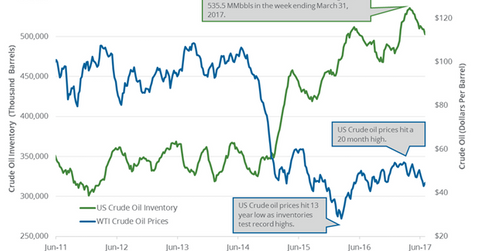Crude Oil Prices Rise: Is It Time for a Collapse?
WTI crude oil prices have risen 9.4% since June 21, 2017. Brent and US crude oil prices are near a three-week high.
Nov. 20 2020, Updated 2:55 p.m. ET

US crude oil prices
WTI (West Texas Intermediate) crude oil (XLE) (USO) (RYE) futures contracts for August delivery rose 0.8% and settled at $45.53 per barrel on July 6, 2017. Brent crude oil futures also rose 0.6% and closed at $48.11 per barrel on July 6, 2017.
Prices rose due to the following:
- a larger-than-expected fall in US crude oil inventories on June 23–30, 2017
- a larger-than-expected fall in US gasoline inventories last week
- an unexpected fall in US distillate inventories on June 23–30, 2017
- short covering
WTI crude oil prices have risen 9.4% since June 21, 2017. Brent and US crude oil prices are near a three-week high due to the following:
- fall in monthly US crude oil production
- a rise in US gasoline demand
- near-record S&P 500 (SPY) (SPX-INDEX)
- US dollar (UUP) at an eight-month low
For more on bullish drivers, read Crude Oil Futures Rose for the Seventh Straight Day.
Higher crude oil prices have a positive impact on oil and gas producers’ earnings like ExxonMobil (XOM), Hess (HES), and Bonanza Creek Energy (BCEI).
However, Brent and WTI crude oil prices fell ~4% on July 5, 2017, due to the rise in OPEC’s crude oil production and exports in June 2017. Brent and WTI crude oil prices have fallen ~20% year-to-date. Prices entered into the bear market on June 21, 2017. Prices might not sustain the recent rally due to the following:
- a rise in weekly US crude oil production on June 23-30, 2017
- Russia might not support deeper or longer production cuts
- expectation of slowing crude oil imports and demand from China, India, and Japan in the coming months
- a rise in Libya, Nigeria, and Iran’s crude oil production
- high crude oil storage in tankers
- a rise in US crude oil exports
- rising concerns about whether the production cut deal will remove excess crude oil from the market
Key moving averages and long-term fundamentals are still bearish for crude oil prices, which suggests that prices could trade lower.
In this series, we’ll discuss crude oil drivers in more detail.
